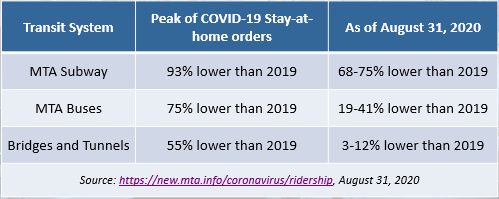 The daily commute has gotten quite the face-lift in 2020. At the peak of COVID-19 stay-at-home orders, the MTA Subway in New York reported ridership levels were down 93% compared to the same period in 2019.
The daily commute has gotten quite the face-lift in 2020. At the peak of COVID-19 stay-at-home orders, the MTA Subway in New York reported ridership levels were down 93% compared to the same period in 2019.
As of August 31, 2020, ridership for the subway remains down 68-75% and buses are down 19-41%. Meanwhile, the use of bridges and tunnels are only down 3-12%. Needless to say, how (and if) employees are commuting is changing.
From all of this, we see four commuter benefit trends emerging that are key to your back-to-work strategies.
Contactless payment is quickly becoming the preferred payment method
In all areas of life and commerce, people are actively seeking out options that minimize direct contact. It is not all that surprising that contactless payments are quickly becoming the preferred payment method.
It allows individuals to hold their personal device or contactless card close to the payment terminal without ever having to touch it or even sign for transactions. According to the Mastercard study “COVID-19 & the advent of the contactless lifestyle”, a vast majority of respondents (80%) were concerned about having to sign or touch a terminal.
Participants with a Beniversal®/eTRAC® Prepaid Mastercard® are able to take advantage of contactless payments by adding their card to Apple Pay, Google Pay or Samsung Pay.
Bicycle commutes and bike sharing services are trending up
Bicycle commuting is a realistic option for many short-to-medium distance commutes, and bike sharing services are increasing across the globe. The bike sharing market is expected to exceed $10 billion by 2025. Additionally, news outlets across the country have reported increases in bike sales, even causing delays or shortages in certain areas of the country.
While there is not currently a pre-tax benefit for reimbursing bicycle expenses, employers should consider adding a post-tax benefit to encourage employees to take advantage of this growing trend.
Seeking alternatives that serve fewer people or provide more open-air flow
People are seeking alternative transportation options which serve fewer people or possibly provide more open air flow. For example, individuals have cited their intent to use ferries over subways and trains. Ferries have capacity limits but also provide open air decks and additional standing room, which provide for more personal space for individual passengers.
Ridesharing and vanpools are also likely to also play a role. Many vanpool services are eliminating the use of middle seats to provide more personal space, along with enhanced cleaning procedures.
In the end, for some employees driving is going to be where their comfort level is. With more employees likely to drive to work, parking can certainly be a concern for employers. Service like SpotHero can provide employees to on-demand access to parking near the office.
Flexibility is the key to a success back to work strategy
Employers and employees are recognizing the need for increased flexibility in their back to work commuting strategies. Here are a few things your commuter benefit solution should provide:
- Allows employees to make on-demand transit purchases to accommodate a continuation of some remote work
- Supports multiple transit options including: transit passes, on-demand, ridesharing and vanpools
- Convenient and timely options for making changes to elections
- Ability to roll unused benefit dollars from one month to the next without concern for a loss of funds
So as you think about back-to-work commuting strategies, keep these four commuter benefit trends in mind, and know that Benefit Resource is ready, willing and able to assist you.



